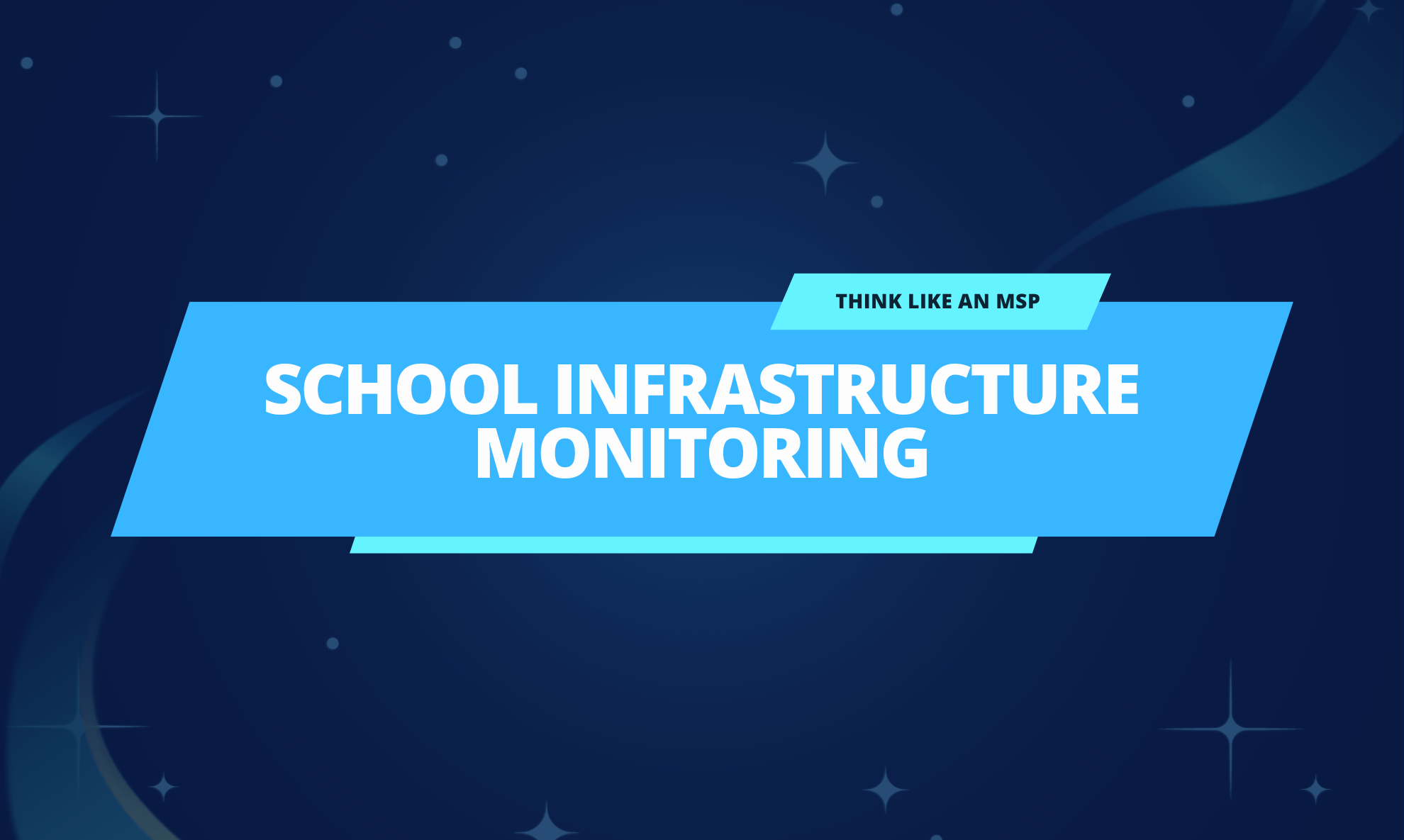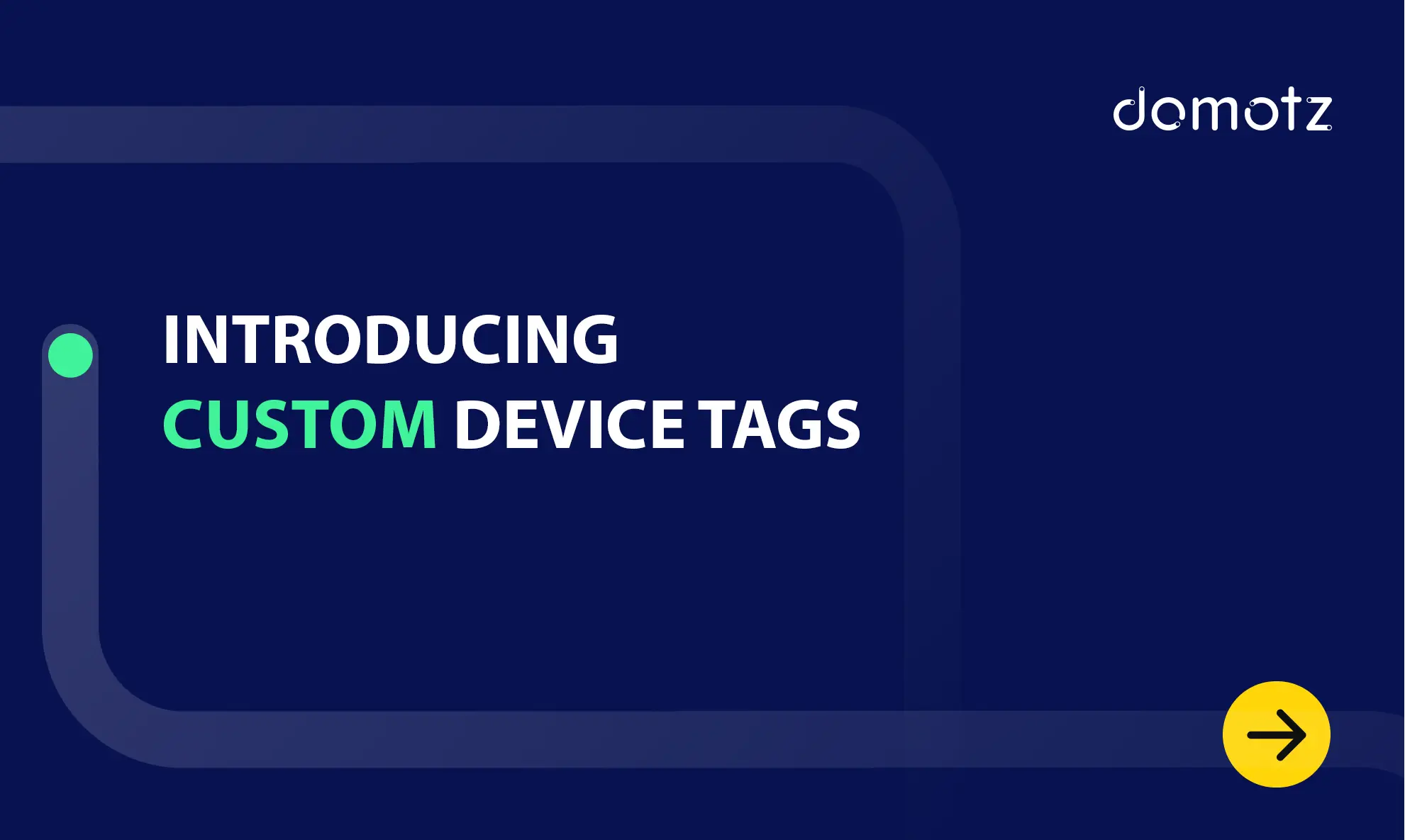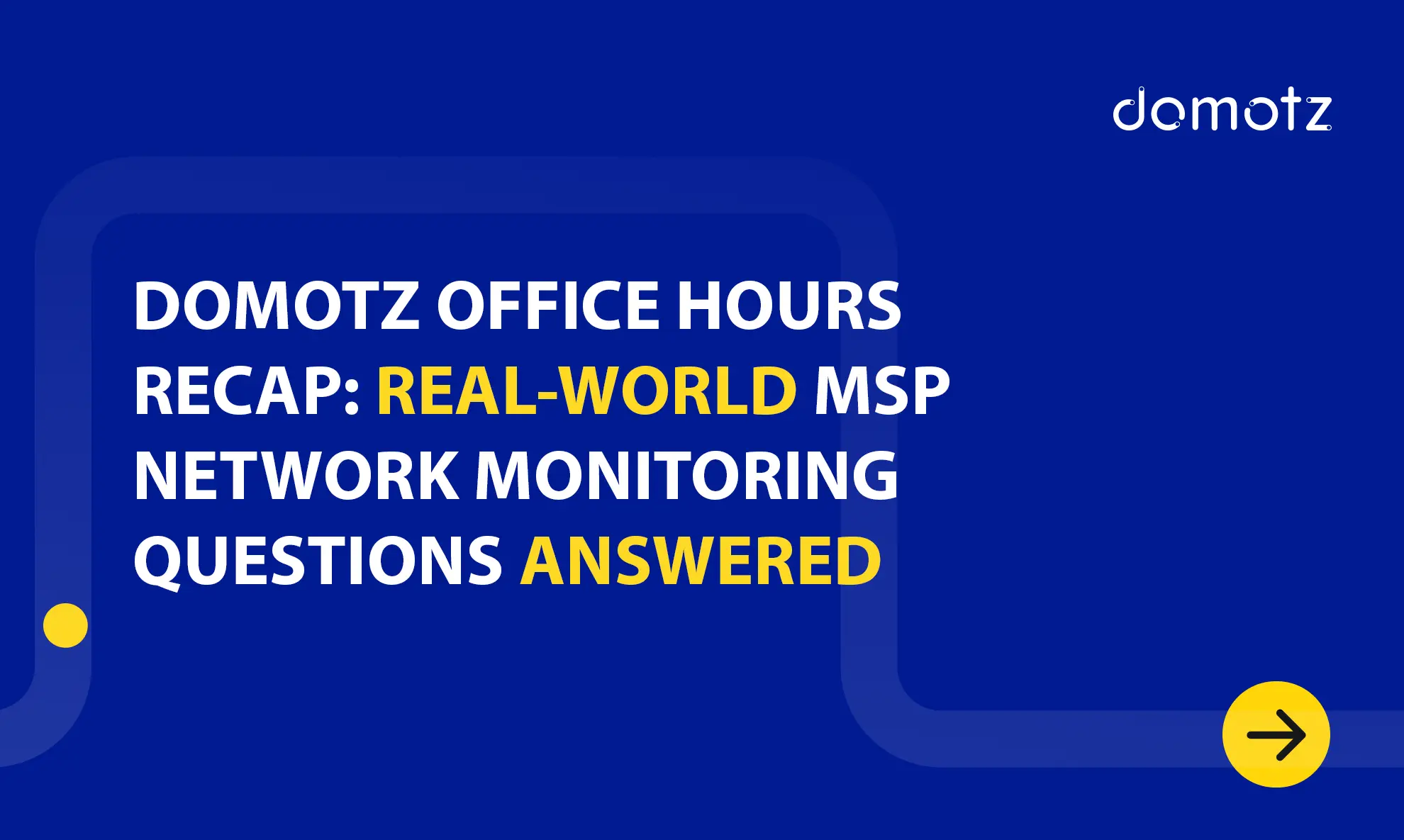A school can be a vast landscape to monitor, and there are many areas that you need to consider. Because tracking a school is such an extensive task, many Managed Service Providers (MSPs) and SysAdmins become specialists in monitoring educational facilities. Learn more about our powerful features for monitoring educational institutions.
In the digital age, security and performance have become more critical than ever in educational institutions. Monitoring various systems, including school infrastructures, is paramount to ensure their safety and functionality.
This article will discuss the ins and outs of school infrastructure monitoring. We will cover all the crucial components that need attention and to consider. In addition, we’ll also discuss some options for monitoring school infrastructure, such as Domotz.
What Is School Infrastructure Monitoring?
So what exactly is school infrastructure monitoring? It refers to the comprehensive process of overseeing technological elements contributing significantly to the education ecosystem’s overall operation. Most of these components are essential to continuity in a school, which means you will need to monitor them too.
Schools have unique needs compared to typical organizations. Their primary purpose is to create a stable and secure learning environment for students and educators alike.
The Most Critical Factors to Consider When Monitoring Infrastructure at a School
#1 Shift to online learning
Firstly, the dependency on technology for lessons has soared immensely in recent years. Smart classrooms with interactive whiteboards and remote learning are now integral to many schools’ curriculum delivery mechanisms. Seamless connectivity ensures students can access resources without disruptions, and it also facilitates teachers’ jobs.
#2 Security
Another significant reason is safeguarding sensitive information, such as student records or staff login credentials. In a school setting, security breaches can have far-reaching consequences, affecting trustworthiness among parents and stakeholders.
Networks often extend campus-wide with many endpoints demanding accurate tracking/management policies. Implementing robust infrastructure monitoring helps detect vulnerabilities before incidents become unmanageable crises.
Learn more about network security.
#3 Proactivity
A comprehensive school infrastructure monitoring plan will address preventive measures like regular hardware evaluation assessments. Having a plan ensures devices operate optimally or software updates and patches happen on time. It minimizes possible exploits cyber actors target.
In addition to this preventive aspect comes prompt problem resolution. Timely interventions when errors or failures occur limit adverse impacts on teachers’ day-to-day activities.
#4 Decision-making
Proper monitoring of school infrastructures also assists administrators in making informed decisions regarding technology investments. It helps them consider factors like current response times against projected demands. It also underlines future growth trend patterns so schools can make adjustments accordingly.
What School Areas to Monitor?
Schools are fast landscapes in which many areas require special attention. Resources are continuously pushed ashore on many fronts, making it challenging to decide where to invest in resources.
Thankfully, MSPs and SysAdmins specialize in addressing these daunting tasks by maintaining close surveillance over hubs. Here are six school areas to monitor:
#1 Administration Area
The administration area comprises virtual offices. You’ll find those for the principal, other administrative staff, and support personnel responsible for managing daily operations.
By closely monitoring the technological systems within this zone, schools can maintain effective communication channels and dynamic scheduling systems. They can also track essential data that contributes significantly to smooth decision-making processes.
#2 Library
Modern libraries are more than just repositories for books. They often feature computer stations and tablets for digital content consumption. There are also usually multiple printers catering to assignments and resource distribution. Monitoring technology within libraries ensures students’ access to essential academic resources remains functional. This minimizes downtime caused by malfunctioning equipment or connectivity issues.
#3 IT Room
IT rooms serve as nerve centers holding servers, network management systems, and storage solutions. These rooms should function optimally to maintain network infrastructure across the campus. Regularly monitoring this space allows administrators to identify potential issues preemptively. These could range from server overheating problems to failed network connections.
#4 Additional Buildings
Many schools have additional buildings, such as outbuildings strategically positioned around the campus. Specific departments or specialized classrooms are housed there – like science labs or art studios. Providing seamless internet connectivity throughout these extended structures necessitates constant surveillance. We must evaluate performance and security measures guarding against unauthorized access.
#5 Classrooms and Labs
Interactive whiteboards, projectors, and learning applications are multiplying. Discussing student success rates can support learning outcomes. Observing classroom technologies helps make responsive adjustments during live lessons.
#6 Cafeteria and Common Areas
Some schools may provide Wi-Fi access in cafeterias or common areas where students can use personal devices during breaks. They often use this time to complete assignments or participate in group projects. Monitoring network usage within these communal spaces will ensure that connectivity remains stable during peak times and guard against potential security risks that could compromise user privacy.
What to Monitor?
Now that we’ve discussed the areas where close monitoring is necessary let’s delve further into the specific components that most need. Within each of the locations listed above, some elements require regular assessment.
#1 The Network
Ideally, you should be monitoring your school’s network 24/7. Keeping track of network performance, bandwidth utilization, and latency can identify problems before they impact students or the staff. A watchful eye over the school’s network will help you maintain secure and reliable connections. Ensure everything runs smoothly without interruptions from potential threats.
A Domotz tip: If you adopt Domotz network monitoring solution, you can rely on a full visibility and control over your infrastructure. We will monitor your network 24/7 and will send you alerts for changes to the network or degradation in network performance.
#2 Desktops and Laptops
Students often use computers during classes and after hours for projects, homework, or extracurricular activities. The continuous usage warrants constant supervision to avoid hardware troubles, software hiccups, or potential data breaches. It becomes increasingly essential for higher grade levels when students research and complete more challenging tasks.
A Domotz tip: Get full network infrastructure visibility and real-time customizable alerts to monitor, manage, and secure your network infrastructure.
#3 Printers
Since classrooms, students, and teachers use printing machines extensively throughout the education environment, they must operate efficiently. Malfunctioning units lead to delays in daily workflows that can escalate into significant problems if nobody keeps tabs on things. Printers connect to the network, so monitoring both locations is pivotal in meeting the demand. Learn all about the features we offer for monitoring printers remotely.
A Domotz tip: Domotz can automatically detect all the printers on your network. Check specific printer consumables with pre-configured SNMP templates. Receive alerts. Start monitoring your printers’ performance with Domotz. Learn more about printer monitoring.
#4 Network Equipment, Server Rooms & Storage
Storage capacities often strain with increasing amounts of essential data collected throughout the academic year. Ensuring server rooms function correctly prevents detrimental loss of critical files/information. Monitoring for cooling effectiveness and performance can increase longevity while avoiding incidents caused by overheating equipment or inefficiency. Learn about server room temperature monitoring.
Other equipment to monitor includes routers, access points, and switches. These devices form the backbone of the school’s network and must always stay operational for students to continue their work. Regular maintenance on printers, such as updating firmware or reconfiguring settings, can keep them performing optimally.
A Domotz tip: Domotz can help you get full details for every server on your network, including discovery and inventory, server status, certificate validity, and remote control. Read about server monitoring and management.
#5 Tablets and Smartphones
Teachers and students now rely on tablets for lessons, note-taking, and communication. Constantly monitoring these devices guarantees their optimal state during usage hours when they are most needed.
A Domotz tip: Domotz can automatically discover tablets and iPhones connected to the network. It continuously scans the network for new devices and updates the inventory accordingly. Domotz can show you essential details such as device name, IP address, MAC address, and manufacturer. We can monitor the online/offline status of tablets and iPhones, alerting administrators if a device goes offline or comes online. It can monitor network performance metrics such as bandwidth usage, signal strength (for Wi-Fi-connected devices), and latency.
#6 Remote Users
Another exciting trend in the academic world is the increasing number of remote users. From students to faculty members, most of them are accessing school systems from outside the premises. Keeping track of their activities and ensuring they’re safe is essential. Establishing secure networks for remote users and monitoring their access can prevent malicious attempts on the system while providing peace of mind.
On-site staff may also require remote access to school resources like lesson plans or test materials from home.
A Domotz tip: Wondering how to connect to a remote device? Domotz can help! Learn how our secure remote connection feature works.
#7 Hardware Purchasing and Lifecycle
The constant churn of the modern electronics market requires schools to make informed hardware purchasing decisions by tracking inventory and performance metrics that can dictate picking a specific vendor or model.
A Domotz tip: Use the Domotz inventory features to keep track of everything you manage to make informed decisions.
#8 New Device Connections
For any new device, be it a student or teacher, that connects to the school’s network, monitoring its activity and ensuring it doesn’t pose any risk to your IT environment is essential.
A Domotz tip: Domotz can send you real-time alerts every time a new device joins your network, allowing identification of potential network security threats. Read about the new device security event feature.
Ten Components of School Infrastructure Monitoring
When selecting an all-encompassing network monitoring solution (we recommend Domotz, of course), be sure these key features come in your chosen solution:
#1 A unified network monitoring dashboard
With so many different components, you’ll need a bird’s eye view of the entire network and the individual components.
Read about custom monitoring.
#2 24/7 Monitoring
Automatic alerts and notifications alert you to any critical devices going down, anomalies, performance issues, or network failures.
Read about alerting with Domotz.
#3 Windows Monitoring
Many school systems will be using Windows systems and a network monitoring tool that offers features for monitoring Windows systems is a good idea. Check out our Windows Monitoring integrations and scripts.
#4 Network Configuration Management
Managing network configurations helps to guarantee the safety of critical network infrastructure devices.
Read about configuration backup and restore.
#5 Security
State-of-the-art encryption and authentication methods ensure that only authorized personnel can access privileged information. You’ll also likely want to invest in a cloud-based network monitoring tool.
#6 Remote Access
Accessing devices like printers that frequently have problems remotely is handy. That means you can instantly fix a printer on-site at a school without being physically present.
Read about secure remote connection.
#7 Remote Power Management
The ability to reboot devices remotely from your office is also convenient because you can immediately fix issues across the school without needing to walk to each different area. If a large school campus, remote power management is even more imperative. Read about remote power management.
#8 Comprehensive Reporting
Receive reports on the performance of application and hardware and network activities. Comprehensive reporting easily visualizes data traffic, bandwidth utilization, and other network parameters.
Learn about network reporting.
#9 Scalability
The solution should adjust to meet changing needs regarding user numbers or devices connected to the network. Using a provider that offers an agentless solution and does not charge per endpoint is a good idea. Learn more about Domotz pricing.
#10 Seamless integrations
Similarly, systems should be able to integrate with existing technologies, such as cloud services or analytics platforms. Learn more about the 1000+ network monitoring integrations available on Domotz.
Cabling Needs for School Infrastructure Monitoring
Aside from digital oversight, implementing robust and organized cabling systems such as Ethernet wires and fiber-optic lines into a school infrastructure is critical. They connect the physical hardware within your establishment and deliver high-quality signals between devices while boosting availability despite fluctuations in demand or usage spikes.
VLANs for School Infrastructure Monitoring
Virtual Local Area Network (VLAN) is another valuable technology to incorporate into your school infrastructure. VLANs create virtual networks within a physical one, isolating different types of traffic from each other. They create separate broadcast domains within the school’s existing networking system, enhancing safety while conserving resources.
The benefits they provide are:
- Heightened security: Restricts unauthorized users’ traffic/access.
- Improved network performance: Reduced data packet collisions.
- Disaster isolation: Prevents failures from affecting non-critical sectors.
- Ease of administration: Enables easy relocation/management of resources.
Learn more about monitoring networks with subnets and VLANs.
Bottom Line
In conclusion, school infrastructure monitoring is a necessary investment that significantly benefits educational facilities. It ensures a smooth and secure learning environment for students and staff. You can effectively monitor your school’s systems by choosing SaaS providers like Domotz for your infrastructure monitoring solutions.
With over 40,000 networks managed across 5,000 partners, Domotz offers an advanced dashboard with valuable features that address any school’s network requirements. Additionally, our seamless integrations with thousands of other platforms will help you keep track of all your networking needs simultaneously.
Start a free trial today and see how you can get the most out of your school infrastructure monitoring.
Further reading:



